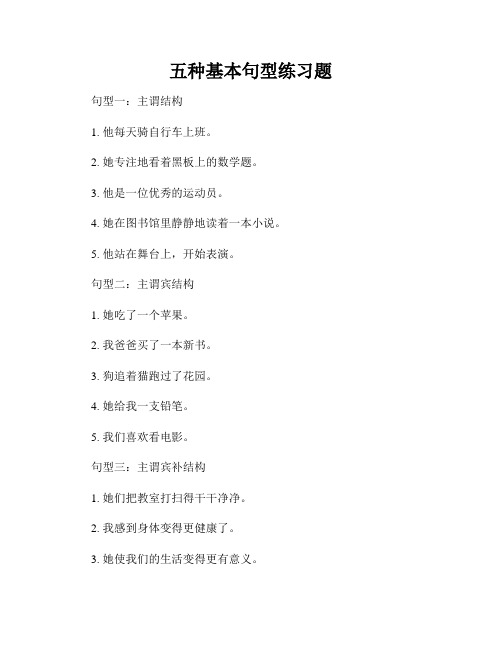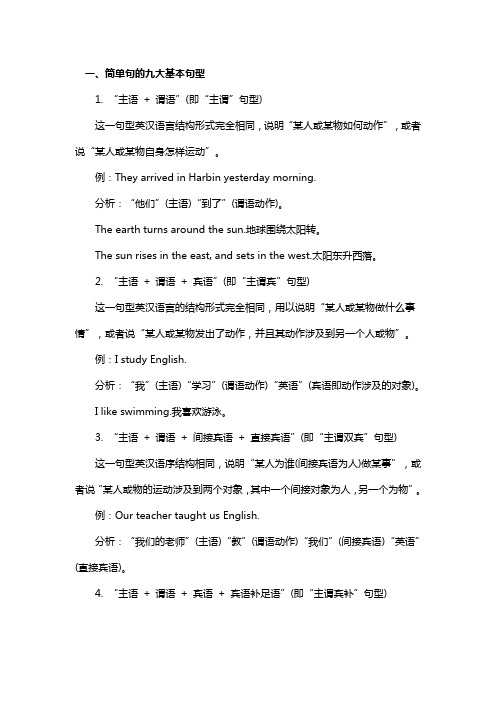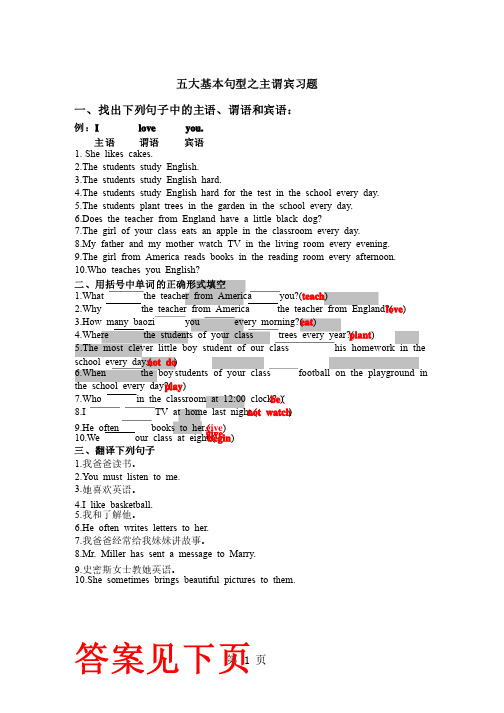基本句型练习主谓宾
五种基本句型练习题

五种基本句型练习题句型一:主谓结构
1. 他每天骑自行车上班。
2. 她专注地看着黑板上的数学题。
3. 他是一位优秀的运动员。
4. 她在图书馆里静静地读着一本小说。
5. 他站在舞台上,开始表演。
句型二:主谓宾结构
1. 她吃了一个苹果。
2. 我爸爸买了一本新书。
3. 狗追着猫跑过了花园。
4. 她给我一支铅笔。
5. 我们喜欢看电影。
句型三:主谓宾补结构
1. 她们把教室打扫得干干净净。
2. 我感到身体变得更健康了。
3. 她使我们的生活变得更有意义。
4. 他被选为班长。
5. 这只小鸟使整个森林变得生机勃勃。
句型四:主系表结构
1. 她是一位聪明的学生。
2. 这个包包看起来很漂亮。
3. 她的笑容让人感到温暖。
4. 这部电影让我流下了眼泪。
5. 这首歌曲让我回忆起过去的时光。
句型五:主谓双宾结构
1. 妈妈给了我一个礼物。
2. 他送给我一束鲜花。
3. 我们给孩子们买了一些玩具。
4. 奶奶经常做好吃的给我们。
5. 爸爸买了一张机票给我。
通过以上的练习题,我们可以巩固五种基本句型的用法。
掌握这些句型的使用,可以帮助我们构建准确、通顺的句子,使我们的表达更加准确和流畅。
希望大家能够认真练习并灵活运用这些句型,提高自
己的写作和口语能力。
通过不断的练习和实践,我们一定能够取得进步!。
主谓宾,简单句

一、简单句的九大基本句型1. “主语+ 谓语”(即“主谓”句型)这一句型英汉语言结构形式完全相同,说明“某人或某物如何动作”,或者说“某人或某物自身怎样运动”。
例:They arrived in Harbin yesterday morning.分析:“他们”(主语)“到了”(谓语动作)。
The earth turns around the sun.地球围绕太阳转。
The sun rises in the east, and sets in the west.太阳东升西落。
2. “主语+ 谓语+ 宾语”(即“主谓宾”句型)这一句型英汉语言的结构形式完全相同,用以说明“某人或某物做什么事情”,或者说“某人或某物发出了动作,并且其动作涉及到另一个人或物”。
例:I study English.分析:“我”(主语)“学习”(谓语动作)“英语”(宾语即动作涉及的对象)。
I like swimming.我喜欢游泳。
3. “主语+ 谓语+ 间接宾语+ 直接宾语”(即“主谓双宾”句型)这一句型英汉语序结构相同,说明“某人为谁(间接宾语为人)做某事”,或者说“某人或物的运动涉及到两个对象,其中一个间接对象为人,另一个为物”。
例:Our teacher taught us English.分析:“我们的老师”(主语)“教”(谓语动作)“我们”(间接宾语)“英语”(直接宾语)。
4. “主语+ 谓语+ 宾语+ 宾语补足语”(即“主谓宾补”句型)这一句型说明“某人或某物要求(使、让)某人做什么”或“某人感觉某人或物怎么样”。
例:He asked her to go there.分析:“他”(主语)“要求”(谓语动作)“她”(宾语即动作涉及的对象)“去那里”(补语—补充说明宾语应做什么)。
5. “主语+ have + 宾语”(即“拥有”句型)这一句型主要用于说明“某人或某物拥有什么(宾语,即有形或无形的资源)”。
例:You have a nice watch. 你有一块漂亮的手表分析:“你”拥有一块漂亮的手表,即你拥有一个可以及时且漂亮的器具。
基本句型练习主谓宾

基本句型(二)主语+及物动词+宾语(?S?+?V?+O?)?1.?昨晚我写了一封信。
?__________________________________________________________?2.?我父亲能流利地说英语。
fluently?__________________________________________________________?3.?你介意我开窗户吗??__________________________________________________________?4.?你们必须在两周之内看完那些书。
?__________________________________________________________?5.?他指出我的作文中的错误。
point?out,??composition?__________________________________________________________?6.?我们必须派人去请医生。
?_________________________________________________________?7.?你在工作中可以依靠他。
?__________________________________________________________?8.?写完作文后,我们必须检查一遍。
go?over?基本句型(二)主语+及物动词+宾语(?S?+?V?+O?)?1.?昨晚我写了一封信。
?__________________________________________________________?2.?我父亲能流利地说英语。
fluently?__________________________________________________________?3.?你介意我开窗户吗??__________________________________________________________?4.?你们必须在两周之内看完那些书。
高中英语中译英练习(五种基本句型)附答案

基本句型汉译英练习主谓宾结构(一)说明:此结构是由主语+谓语+宾语够成。
其中的谓语动词须是及物的动词或及物的动词词组。
宾语须是名词或相当于名词的成分。
翻译练习:昨晚我写了一封信。
今天下午我想同你谈谈。
这本书他读过多次了。
他们成功地完成了计划。
你们必须在两周内看完这些书。
那位先生能流利地说三种语言。
我收到了笔友从澳大利亚寄来的信。
Jim 还不会自己穿衣服。
我们大家都相信Jack 是一个诚实男孩。
他不知道说什麽好。
他每天早晨洗冷水澡。
我开窗户你在意吗?参考答案:1.I wrote a letter last night.2.I want to talk with you this afternoon.3.He has read this book many times.4.They have carried out the plan successfully.5.You must finish reading these books in two weeks.6.That gentlemen can speak three languages fluently.7.I received a letter from my pen friend in Australia.8.Jim cannot dress himself.9.All of us believe that Jack is an honest boy.10.He did not know what to say.11.He takes a cold bath every morning.12.Do you mind my opening the window?主谓宾结构(二)说明:此结构中的谓语动词常常是动词词组,分两种情况:1.及物动词+副词,2.不及物动词+介词。
1.含有away, out, forward, up 等副词的动词词组是可拆分的。
主谓宾简单句

主谓宾-简单句一、简单句的九大基本句型1. “主语+ 谓语”(即“主谓”句型)这一句型英汉语言结构形式完全相同,说明“某人或某物如何动作”,或者说“某人或某物自身怎样运动”。
例:They arrived in Harbin yesterday morning.分析:“他们”(主语)“到了”(谓语动作)。
The earth turns around the sun.地球围绕太阳转。
The sun rises in the east, and sets in the west.太阳东升西落。
2. “主语+ 谓语+ 宾语”(即“主谓宾”句型)这一句型英汉语言的结构形式完全相同,用以说明“某人或某物做什么事情”,或者说“某人或某物发出了动作,并且其动作涉及到另一个人或物”。
例:I study English.分析:“我”(主语)“学习”(谓语动作)“英语”(宾语即动作涉及的对象)。
I like swimming.我喜欢游泳。
3. “主语+ 谓语+ 间接宾语+ 直接宾语”(即“主谓双宾”句型)这一句型英汉语序结构相同,说明“某人为谁(间接宾语为人)做某事”,或者说“某人或物的运动涉及到两个对象,其中一个间接对象为人,另一个为物”。
例:Our teacher taught us English.分析:“我们的老师”(主语)“教”(谓语动作)“我们”(间接宾语)“英语”(直接宾语)。
4. “主语+ 谓语+ 宾语+ 宾语补足语”(即“主谓宾补”句型)这一句型说明“某人或某物要求(使、让)某人做什么”或“某人感觉某人或物怎么样”。
例:He asked her to go there.分析:“他”(主语)“要求”(谓语动作)“她”(宾语即动作涉及的对象)“去那里”(补语—补充说明宾语应做什么)。
5. “主语+ have + 宾语”(即“拥有”句型)这一句型主要用于说明“某人或某物拥有什么(宾语,即有形或无形的资源)”。
五种基本句型_主谓(宾)两种结构_实用练习加详细解析

五种基本句型——主谓(宾)结构主(语)+谓(语)练习一判断下列句子是主谓结构还是主谓宾结构,如果是主谓宾结构请指出是由什么充当的宾语(名词、代词、动词不定式、doing 等等)1 He arrived yesterday.2 The boy is crying loudly.3 She died in 2000.4 The man disappeared in the street.5 I like music.6 She wanted some help7 I slept well last night. 8 Iom built a house last year.9 I bought a computer in the street yesterday10 .Tom often swims in the river11 .My sister works in that factory.12 .The sun is rising. 13 .They know him.14 .He enjoys listening to music. 15 .My watch has stopped.16 .It is snowing hard. 17 .My grandma coughed all night.18 .She was cooking. 19 .I found a box under the bed.20 .Kate described the picture. 21 .I hate to go there.22 .He remembered telling you. 23 .His aunt will come.24 .The farmer works very hard. 25 .The flowers need watering.26 .We usually watch TV on Saturday evening.27 .She has cleaned the room. 28 .He liked collecting stamps.29 .Both of them work in the school library.30 .Kate is running fast. 31 .The ship moves slowly32 .He wanted two boxes watches. 33 .I read every book in the school library.34 .You can understand me. 35 .We can watch TV.36 .The children are reading carefully. 37 .Mr. Smith speaks very fast.38 .The train has arrived. 39 .They won’t come today.40 .You mustn’t talk loud 41 .You will close the door.42 .She decided to wait. 43 .I met one of my friends in Beijing.44 .He passed the exam last year. 45 .China has a large population.46 .He knows a little English. 47 .I have received your letter.48 .The students answered the questions.49 .He is beginning a new life. 50 .He learned to ride a bike yesterday.51 .Have you finished writing? 52 .I suggest trying it once more.53 .I want to go to college. 54 .She often dances in the park.55 .Kate often studies at school at night.练习三答案1 He arrived yesterday.他昨天到达。
英语五大基本句型三之主谓宾分析+习题

五大基本句型之主谓宾习题一、找出下列句子中的主语、谓语和宾语:例:I love you.主语谓语宾语1.She likes cakes. 2.The students study English. 3.The students study English hard. 4.The students study English hard for the test in the school every day. 5.The students plant trees in the garden in the school every day. 6.Does the teacher from England have a little black dog? 7.The girl of your class eats an apple in the classroom every day. 8.My father and my mother watch TV in the living room every evening. 9.The girl from America reads books in the reading room every afternoon. 10.Who teaches you English? 二、用括号中单词的正确形式填空1.What the teacher from America you?(teach) 2.Why the teacher from America the teacher from England?(love) 3.How many baozi you every morning?(eat) 4.Where the students of your class trees every year?(plant) 5.The most clever little boy student of our class his homework in the school every day.(n otnot do) 6.When the boy students of your class football on the playground in the school every day?(play) 7.Who in the classroom at 12:00 clock? (be) 8.I TV at home last night.(not watch) 9.He often books to her.(g ivegive) 10.We our class at eight.(begin) 三、翻译下列句子1.我爸爸读书。
五大基本句型专项练习(含答案)

五大基本句型专项练习一、写出下列句子结构1. Tom is a student.(主系表)_________________________________________________ 2. She goes to school every day.(主谓宾)_________________________________________________ 3. Linda teaches us English. (主谓间宾直宾)_________________________________________________ 4. The weather gets hot in summer.(主系表)_________________________________________________ 5. She looks beautiful. (主系表)_________________________________________________ 6. The flower smells good.(主系表)_________________________________________________ 7. The soup tastes delicious.(主系表)_________________________________________________ 8. My mother bought a dress for me.(主谓直宾间宾)_________________________________________________ 9. Learning English makes me happy.(主谓宾宾补)_________________________________________________ 10. They were kind.(主系表)_________________________________________________二、标出下面句子的成分。
- 1、下载文档前请自行甄别文档内容的完整性,平台不提供额外的编辑、内容补充、找答案等附加服务。
- 2、"仅部分预览"的文档,不可在线预览部分如存在完整性等问题,可反馈申请退款(可完整预览的文档不适用该条件!)。
- 3、如文档侵犯您的权益,请联系客服反馈,我们会尽快为您处理(人工客服工作时间:9:00-18:30)。
基本句型练习主谓宾 IMB standardization office【IMB 5AB- IMBK 08- IMB 2C】
基本句型(二)主语+及物动词+宾语(S+V+O) 1.昨晚我写了一封信。
__________________________________________________________
2.我父亲能流利地说英语。
fluently
__________________________________________________________
3.你介意我开窗户吗
__________________________________________________________
4.你们必须在两周之内看完那些书。
__________________________________________________________
5.他指出我的作文中的错误。
pointout,composition
__________________________________________________________
6.我们必须派人去请医生。
_________________________________________________________
7.你在工作中可以依靠他。
__________________________________________________________
8.写完作文后,我们必须检查一遍。
goover
基本句型(二)主语+及物动词+宾语(S+V+O)
1.昨晚我写了一封信。
__________________________________________________________
2.我父亲能流利地说英语。
fluently
__________________________________________________________
3.你介意我开窗户吗
__________________________________________________________
4.你们必须在两周之内看完那些书。
__________________________________________________________
5.他指出我的作文中的错误。
pointout,composition
__________________________________________________________
6.我们必须派人去请医生。
_________________________________________________________
7.你在工作中可以依靠他。
__________________________________________________________
8.写完作文后,我们必须检查一遍。
goover
__________________________________________________________
基本句型(二)主语+及物动词+宾语(S+V+O)
1.昨晚我写了一封信。
__________________________________________________________
2.我父亲能流利地说英语。
fluently
__________________________________________________________
3.你介意我开窗户吗
__________________________________________________________
4.你们必须在两周之内看完那些书。
__________________________________________________________
5.他指出我的作文中的错误。
pointout,composition
__________________________________________________________
6.我们必须派人去请医生。
_________________________________________________________ 7.你在工作中可以依靠他。
__________________________________________________________ 8.写完作文后,我们必须检查一遍。
goover
__________________________________________________________ 基本句型(二)主语+及物动词+宾语(S+V+O)
1.昨晚我写了一封信。
__________________________________________________________ 2.我父亲能流利地说英语。
fluently
__________________________________________________________ 3.你介意我开窗户吗
__________________________________________________________ 4.你们必须在两周之内看完那些书。
__________________________________________________________ 5.他指出我的作文中的错误。
pointout,composition
__________________________________________________________ 6.我们必须派人去请医生。
_________________________________________________________ 7.你在工作中可以依靠他。
__________________________________________________________ 8.写完作文后,我们必须检查一遍。
goover
__________________________________________________________ 基本句型(二)主语+及物动词+宾语(S+V+O)
1.昨晚我写了一封信。
__________________________________________________________ 2.我父亲能流利地说英语。
fluently
__________________________________________________________ 3.你介意我开窗户吗
__________________________________________________________ 4.你们必须在两周之内看完那些书。
__________________________________________________________ 5.他指出我的作文中的错误。
pointout,composition
__________________________________________________________ 6.我们必须派人去请医生。
_________________________________________________________ 7.你在工作中可以依靠他。
__________________________________________________________ 8.写完作文后,我们必须检查一遍。
goover
__________________________________________________________ 基本句型(二)主语+及物动词+宾语(S+V+O)
1.昨晚我写了一封信。
__________________________________________________________ 2.我父亲能流利地说英语。
fluently
__________________________________________________________ 3.你介意我开窗户吗
__________________________________________________________
4.你们必须在两周之内看完那些书。
__________________________________________________________ 5.他指出我的作文中的错误。
pointout,composition
__________________________________________________________ 6.我们必须派人去请医生。
_________________________________________________________ 7.你在工作中可以依靠他。
__________________________________________________________ 8.写完作文后,我们必须检查一遍。
goover
__________________________________________________________。
